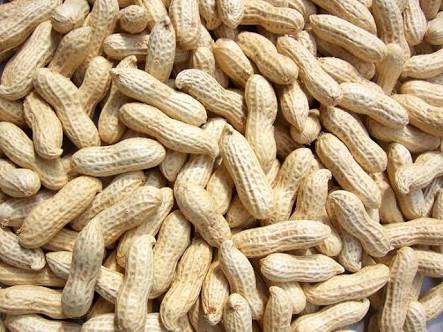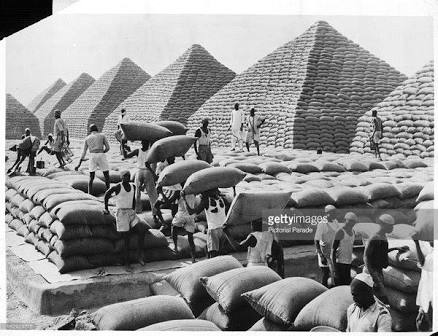| The Connection Between Nigerian Groundnut Pyramid And Aliko Dangote by DaudaAbu(m): 1:03pm On Aug 05, 2016 |
Groundnut pyramids
Groundnut pyramids were pyramid-like structures made from groundnut sacks. The pyramids were built in northern Nigeria in cities such as Kano, where groundnut production was a key part of the economy. They were viewed as both a tourist attraction and a symbol of wealth. In the 1960s and 70s, as production in Nigeria shifted from agriculture to oil, the groundnut pyramids disappeared. Recently, the Nigerian government has made efforts to revive the groundnut industry and rebuild the pyramids.
History
Groundnut pyramids were the invention of Alhassan Dantata, a prominent nut trader[b][/b]. Dantata came to Kano in 1919 and within five years was one of the most successful businessmen, supplying the Royal Niger Company (RNC) with most of their groundnuts. Dantata's company kept their groundnuts at a facility in Kofar Nassarawa, and they stacked the bags in the shape of a pyramid before they were shipped. One groundnut pyramid could be made from as much as 15,000 full groundnut bags.
Groundnut pyramids were built all across northern Nigeria, in cities like Kofar Mazugal, Brigade, Bebeji, Malam Madori and Dawakin Kudu. The pyramids became synonymous with Nigeria's agriculture wealth; a postage stamp even featured a groundnut pyramid. However, as groundnut production declined in the 1970s and 80s the groundnut pyramids disappeared and were replaced with buildings.
Modern efforts
On February 24, 2014, Dr. Akimwumi Adesina, Minister of Agriculture and Rural Development launched a groundnut value chain project. This project is a joint venture between the Federal Government (FG) of Nigeria and the International Crops Research Institute for the Semi-Arid Tropics (ICRISAT). Their aim is twofold: to increase Nigeria's groundnut production and rebuild the groundnut pyramids. President Goodluck Jonathan reiterated the government's desire to rebuild the pyramids in a bridge dedication speech in March 2015. 

|
| Re: The Connection Between Nigerian Groundnut Pyramid And Aliko Dangote by DaudaAbu(m): 1:09pm On Aug 05, 2016 |
Alhassan Dantata (1877 – 17 August 1955) was a Northern Nigerian trader in kola nuts, ground nuts and distributor of European goods. He supplied large British trading companies with raw materials and also had business interests in the Gold Coast. At the time of his death he was one of the wealthiest men in West Africa. Introduction to Trading
Probably after being freed from slavery around 1894, Alhassan joined a Gonja bound caravan to see his mother. He purchased some items in Bebeji, he sold half of them on the way and the rest in Accra. He might have hoped his wealthy mother would allow him to live with her and find him work among the Gold Coast Agalawa community. After only a rest of one day, she took him to a Mallam and asked him to stay there until he was ready to return to Bebeji. Alhassan worked harder in Accra than he did in Bebeji. After the usual reading of the Qur'an, Alhassan Dantata had to go and beg for food for his mallam and himself. He worked for money on Thursdays and Fridays. As was the tradition, the bulk of his earnings went to his Mallam. At some point he returned to Bebeji to his religious studies and work. There, Tata continued to insist that he must save something everyday. European trading companies
In 1912, when the Europeans started to show an interest in the export of groundnut, they contacted the already established Kano merchants through Emir Abbas and their chief agent, Adamu Jakada. Some established merchants of Kano like Umaru Sharubutu, Maikano Agogo accepted their offer.
Alhassen Dantata was already familiar with the manner by which traders could make fortunes by buying cocoa for Europeans in the Gold Coast. He had several advantages over other Kano business men: language, wealth and age. He could speak some English and already had direct dealings with Europeans in Lagos and Accra. He had substantial amounts of capital. Unlike other established Kano merchants, he was in his mid-thirties, with a small family and retinue to support. Despite the famine in Kano in 1914, he quickly dominated the groundnut purchasing business via promotions, loans and contacts.
In 1918, the UK-based Royal Niger Company (later became the United Africa Company) searched for an agent to purchase groundnuts for them, and Dantata responded to their offer.It is said that he used to purchase about half of all the nuts purchased by the United Africa Company in northern Nigeria.
By 1922 Dantata had become the richest businessman in Kano, surpassing other merchant traders. In 1929, when the Bank of British West Africa opened a branch in Kano, Dantata placed 20 camel-loads of silver coins in it. (For religious reasons, his money collected no interest). Shortly before his death, he pointed to sixty "groundnut pyramids" in Kano and said, "These are all mine".
Alhassen Dantata applied for a license to purchase and export groundnuts in 1940, on the same level as the United Africa Company. However, it was not granted because of world wide military and economic conditions. In 1953–54 he became a licensed buying agent, which allowed him to sell directly to the Nigerian Groundnut Marketing board instead of another firm.
Dantata had many business connections both in Nigeria and in other West African countries, particularly the Gold Coast. He dealt, not only in groundnuts and kola, but also in other merchandise. He traded in cattle, cloth, beads, precious stones, grains, rope and other things. Got it all from https://en.m.wikipedia.org/wiki/Alhassan_Dantata |
| Re: The Connection Between Nigerian Groundnut Pyramid And Aliko Dangote by DaudaAbu(m): 1:13pm On Aug 05, 2016 |
Descendants of Alhassan Dantata
Some descendants include
Mamuda Dantata (1922–1983): son, founder of the West African Pilgrims Association and a currency trader
Sanusi Dantata (1917-1997): son, a successful businessman[8]
Alhaji Abdulkadir Dantata: grandson[9]
Aliko Dangote (1957-): great grandson, a billionaire
Ahmadu Dantata (1916-1960): son, a politician
Aminu Dantata (1931-): son, a businessman |
| Re: The Connection Between Nigerian Groundnut Pyramid And Aliko Dangote by interiorking(m): 1:27pm On Aug 05, 2016 |
Who is dangote's father? |
| Re: The Connection Between Nigerian Groundnut Pyramid And Aliko Dangote by DaudaAbu(m): 1:39pm On Aug 05, 2016 |
interiorking:
Who is dangote's father? Parent(s)
Hajia. Mariya Sanusi Dantata (mother)
Mohammed Dangote (father)
Relatives Sani Dangote (brother) |
| Re: The Connection Between Nigerian Groundnut Pyramid And Aliko Dangote by DaudaAbu(m): 1:43pm On Aug 05, 2016 |
The fact is that Dangote just like his great grand father was a commodity trader
Also ,his great grandfather is one of the richest person in his time just as Dantoge is the richest Nigerian now |